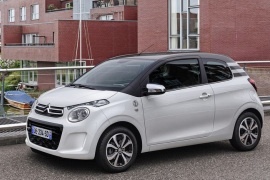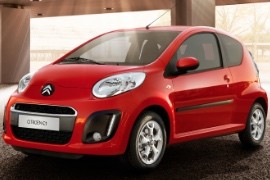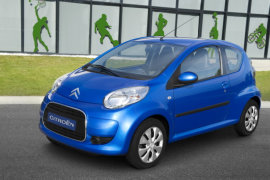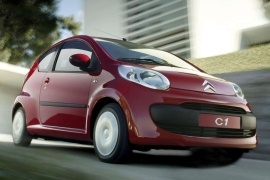CITROEN C1 3 Doors Models/Series Timeline, Specifications & Photos
First production year: 2005
Engines: Gasoline, Diesel
Body style: Hatchback
The PSA french group made a joint-venture with Toyota to build a small city car. The result was a trio: the Citroen C1-Peugeot 108-Toyota Aygo. All three vehicles were built on the same factory, but with some aesthetic differences. That was a cross-brand badge-engineering.
For the 2014 triplets, the PSA and Toyota agreed to make a different styling so that the buyers will feel like they had a choice. The C1 was allowed to have the “angry” face, with headlights narrower on the inside, the bigger trapezoidal grille and somehow more aggressive lines on the hood. In the rear, the taillights were conventional.
Inside the cabin, there is enough room for the front seats and somehow limited for the rear passengers. Compared with its 5-door sibling, the 3-doors C1 has larger front doors. The front seats can be tilted to make room for the rear passengers.
The very short wheelbase, of just 2.3 m (92.1”) didn't allow too much room. But for short in-city trips, it is fine. The C1 can also receive a soft roof, that will transform the car into a top-cabriolet. The dashboard is plain and simple, with a 7” infotainment unit placed on the center console. It has a screen-mirroring with the smartphone. The same screen is used for the rearview camera.
For the powertrains, the offer is not that much. It had engines ranging between 68 and 82 hp mated either with a 5-speed manual transmission or with an automated gearbox with the same number of gears.
Like its siblings, the Peugeot 107 and Toyota Aygo, Citroen improved the C1 for the second time during its first generation with mild exterior and interior updates.
When PSA (Peugeot-Citroen) and Toyota joined forces to develop their city-segment representatives and build it in the Czech Republic, they aimed for fuel-efficiency and easy-to-park vehicles. Citroen introduced the first generation in 2005, and it was supposed to replace it in 2012. Due to the world financial crisis, the two big partners decided to postpone introducing a new generation and offered just a facelifted version for the 2012 model.
On the outside, the most visible change for the C1 was the introduction of the LED daytime running lights incorporated into the front bumper. For those, the carmaker had to change the front bumper completely and included side black areas where the optional fog-lights were included. Like the original model, the 3-door C1 featured pop-out rear windows for better interior ventilation.
Inside, the C1 offered room for four occupants, if the rear ones were smaller children. The carmaker didn't even try to install three head-rests in the back. It was clearly a 2+2 vehicle. Citroen offered the tachometer in the instrument panel options list, but it changed the CD-player and the center stack's top with an open storage compartment. Previously, the C1 featured a box with a lid on it.
Under the hood, the revised engine range deleted the diesel engine and kept only the 1.0-liter, naturally aspirated gasoline unit. Citroen paired it with a 5-speed manual or a 5-speed automated version.
The French carmaker unveiled a facelifted version for the C1 supermini vehicle in 2009 and made it more environmentally friendly than before.
Citroen refreshed most of its vehicles in just a few months: the C2, C4, C5, and Berlingo received improvements to make them fit for the Euro 5 emission standards. The carmaker unveiled the refreshed C1 in January 2009 in both three- and five-doors.
Thanks to the improved front fascia, the three-door C1 featured a new silver trim around the grille. The new bumper incorporated a different, mouth-like grille, crossed by a horizontal bar for the license plate. The three-door C1 sported or not a black rubber strip that protected the door from minor parking scratches and body-colored door handles depending on the trim level. Unlike its five-door sibling, which featured a pop-out window for the rear passengers, the three-door C1 had fixed triangular glass areas for them.
The carmaker tried to upgrade the interior with better materials. There was no instrument cluster apart from the steering-column mounted speedometer. Citroen offered, as an option, an additional dial for the tachometer mounted on top of the speedometer. It was an original, yet unusual, arrangement. Like its non-facelifted version, the C1 featured a split-folding rear bench, suitable for two passengers.
Under the hood, Citroen and Toyota developed a new engine management unit that lowered the emissions to fit into the Euro 5 levels. The carmaker offered the vehicle with a manual or a 5-speed automated gearbox.
When PSA (Peugeot-Citroen) and Toyota decided to build a car together, they turned their attention toward the mini segment, and the result was the trio Citroen C1-Toyota Aygo-Peugeot 107.
While the Citroen Saxo had to go, the new proposal was considered a smart business move for the French carmaker, who could share the development and production costs with the biggest carmaker in the world, Toyota. It also benefited from its experience with the mini segment.
Citroen adopted a style with rounded headlights, extended on the sides with the turn-signals. The double-chevron chromed badge adorned its short hood, and the grille was moved to the lower side of the bumper. A black, plastic mold protected the car from small parking bumps. It was notorious how the French drivers used to make room in the parking lots by pushing other vehicles.
Inside, depending on the trim-level, the C1 featured a tachometer mounted on top of the speedometer. Citroen installed both of them on the steering column assembly. The center stack's simple layout allowed easy use of the HVAC controls—the C1 featured power windows at the front and fixed windows in the rear. Thanks to its wide doors, the three-door version allowed easier access to the front seats than the five-door version.
Under the hood, Toyota provided the 1.0-liter gasoline engine and PSA (Peugeot-Citroen Group) the 1.4-diesel version. Both versions were paired as standard to a 5-speed manual, while a 5-speed automated version was available as an option. The latter consisted of a manual gearbox and a computer-controlled clutch-actuator system.



